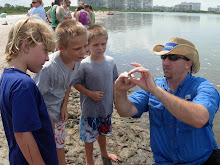 One of the major threats to sea turtles is the incidental capture, injury, and/or death associated with interactions with fishing gear. In the 1970s, scientists noted a reduction in sea turtle populations and, following the enactment of the Endangered Species Act, some species of sea turtles were listed as endangered. Subsequently, over many years, NOAA Fisheries and the U.S. Fish and Wildlife Service attempted to determine causes for these reductions. In the 1980s, they determined that shrimp trawls contributed to sea turtle mortality. Turtle Excluder Devices (TED) in shrimp trawl nets were developed and tested throughout the 1980s and ‘90s in efforts to provide safe methods for turtles to escape almost as soon as they were caught in the net.
One of the major threats to sea turtles is the incidental capture, injury, and/or death associated with interactions with fishing gear. In the 1970s, scientists noted a reduction in sea turtle populations and, following the enactment of the Endangered Species Act, some species of sea turtles were listed as endangered. Subsequently, over many years, NOAA Fisheries and the U.S. Fish and Wildlife Service attempted to determine causes for these reductions. In the 1980s, they determined that shrimp trawls contributed to sea turtle mortality. Turtle Excluder Devices (TED) in shrimp trawl nets were developed and tested throughout the 1980s and ‘90s in efforts to provide safe methods for turtles to escape almost as soon as they were caught in the net. Technologically, a TED is a grid in the neck of a shrimp trawl net, which has an opening in the bottom or top mesh to allow a turtle caught in the net to escape. When turtles and other large animals are caught at the mouth of a trawl, they bump into the grid bars and slide through the opening in the mesh. Shrimp and other small animals pass through the bars of the grid into the tailbag or cod end of the trawl net. NOAA Fisheries has been able to show that TEDs are effective at excluding up to 97 percent of sea turtles with minimal loss of shrimp. Over the years, several designs of TEDs have been approved and used. Changes continue to be made, often due to input and support from the shrimping industry.
Technologically, a TED is a grid in the neck of a shrimp trawl net, which has an opening in the bottom or top mesh to allow a turtle caught in the net to escape. When turtles and other large animals are caught at the mouth of a trawl, they bump into the grid bars and slide through the opening in the mesh. Shrimp and other small animals pass through the bars of the grid into the tailbag or cod end of the trawl net. NOAA Fisheries has been able to show that TEDs are effective at excluding up to 97 percent of sea turtles with minimal loss of shrimp. Over the years, several designs of TEDs have been approved and used. Changes continue to be made, often due to input and support from the shrimping industry. |
| http://seawifs.gsfc.nasa.gov/OCEAN_PLANET/HTML/peril_bycatch.html |
 Current rules require that shrimp trawlers fishing in state and federal waters of the southeastern U.S. (South Atlantic and Gulf of Mexico waters) use one of several NOAA approved TEDs. Since 1990, TEDs or some comparable apparatus/activity have also been required in foreign shrimp fleets that export wild caught shrimp to the U.S. Programs are now in place in approximately 15 countries. Also in 2002, NOAA Fisheries, at the request of the Gulf of Mexico Fishery Management Council, proposed that all Gulf shrimp vessels be required to carry a permit to trawl in federal waters.
Current rules require that shrimp trawlers fishing in state and federal waters of the southeastern U.S. (South Atlantic and Gulf of Mexico waters) use one of several NOAA approved TEDs. Since 1990, TEDs or some comparable apparatus/activity have also been required in foreign shrimp fleets that export wild caught shrimp to the U.S. Programs are now in place in approximately 15 countries. Also in 2002, NOAA Fisheries, at the request of the Gulf of Mexico Fishery Management Council, proposed that all Gulf shrimp vessels be required to carry a permit to trawl in federal waters.
To learn more about the regulatory history of TEDs visit: http://www.lsu.edu/seagrantfish/management/TEDs&BRDs/teds_history.htm
Adapted from: http://www.lsu.edu/seagrantfish/management/TEDs&BRDs/teds.htm



